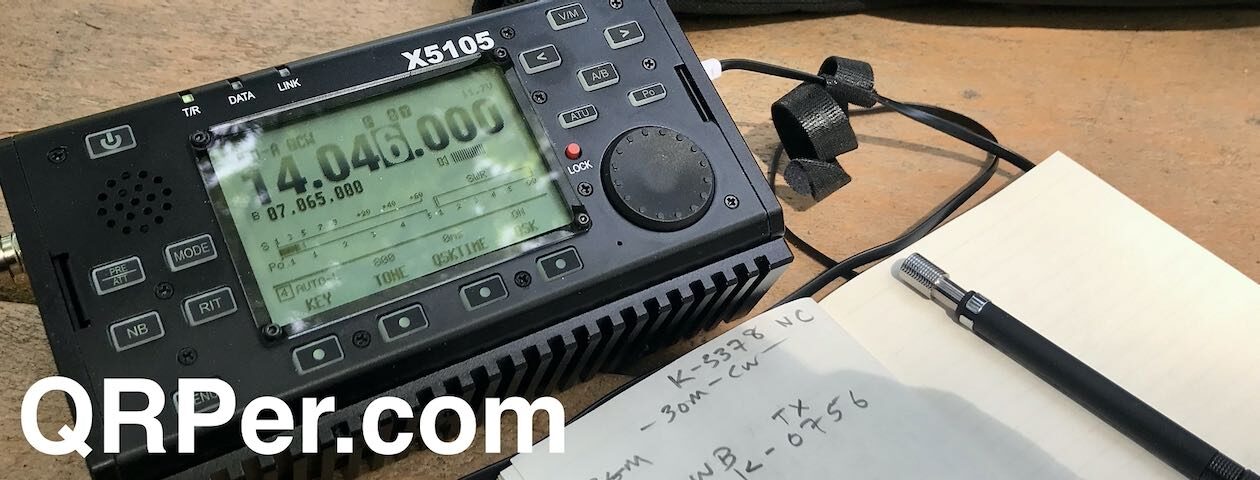Last month, I received a comment and question from Gordon (KO4AYC) here on QRPer.com:
“I am curious if anyone has used the AX1 with the AXE1 40 meter extender and tuned this antenna for 40 meters using the Emtech ZM-2 tuner?”
For the life of me, I couldn’t remember if I’d tried this combo before.
The ZM-2 ATU is a simple manual antenna tuner that you can purchase either as a fun-to-build kit or fully assembled and tested.
I’ve owned my ZM-2 for many years, and I believe every QRP field operator should have one. They do a brilliant job of matching random wire antennas and taking your resonant antenna to a non-resonant band. Being a manual ATU, they require no power source. If you’d like to read a quick tutorial on tuning the ZM-2, read this previous post.
I figured the easiest way to answer Gordon’s question was to give it a go!
The AX1 does require a counterpoise, so before hitting the field, I did check to make sure there was continuity between the shield of the ZM-2’s BNC connector and the black binding post when the ZM-2 was switched to “GND” for coax antennas. Fortunately, there was! I loved this idea because it meant that no matter the radio, I knew I’d have an easy connection to ground for the AX1 counterpoise.
Blue Ridge Parkway (K-3378)
On Wednesday, February 21, 2024, I grabbed the ZM-2, AX1, and AXE 40M coil (since Gordon specifically asked about 40M) along with my Yaesu FT-818ND. It was time to see just how effectively the ZM-2 might match the AX1.

Upon arrival, I began setting up the station.
Even though it was approaching 2:00 PM locally, I wanted to see if the ZM-2 would match the AX1 (with AXE coil) on 40 meters first. I didn’t expect a lot of activity on that band so early in the afternoon, but I figured I could hopefully work a couple of stations.
I attached the AX1 directly to the ZM-2 antenna port and deployed the whip and 40M counterpoise.
It was a bit gusty, and I quickly realized that the AX1 might topple over in the wind. To secure the antenna, I used the handle of my GR1 backpack. It was a semi-effective arrangement (actually, the handle sort of pulled the antenna toward the pack, which wasn’t ideal either–I eventually removed it).
In calm conditions, I wouldn’t worry about the antenna toppling over; the ZM-2 provides enough of a base that it’s stable. In the wind, though, you’ll definitely need to secure the ZM-2/AX1 combo to keep it from being blown over.
My plan was to start on 40 meters, then also hit 30, 20, and 17 meters. This would give me an opportunity to see if the ZM-2 could match the AX1 on multiple bands.
Side note: I can’t remember if I mentioned this in a previous field report, but one sad bit of news for me is that there’s a new source of QRM at the Folk Art Center. It’s likely coming from the VA medical complex next door, but it raised the noise floor to at least S5 on most bands. This will make it more difficult for me to work weak signals from this particular POTA site.
Then again? My buddy Alan (W2AEW) recently pointed out to me that compromised antennas like the AX1 don’t feel the effects of local QRM as a higher-gain antenna would. I’d been thinking the same thing.
Gear:
 Note: All Amazon, CW Morse, ABR, Chelegance, eBay, and Radioddity links are affiliate links that support QRPer.com at no cost to you.
Note: All Amazon, CW Morse, ABR, Chelegance, eBay, and Radioddity links are affiliate links that support QRPer.com at no cost to you.
- Yaesu FT-818ND
- WINDCAMP 3000mAh LIPO battery for FT-818/817
- WINDCAMP Anderson PowerPole Adapter for FT817/818
- Portable Zero FT-817 Side Rails and Bail
- Emtech ZM-2
- Elecraft AX1 packed in a Maxpedition Fatty Pouch
- VK3IL Pressure Paddle V2
- GraphGear 0.9mm 1000 Automatic Drafting Pencil
- Rite In The Rain Top Spiral Notebook
- GoRuck GR1 USA pack
- Camera: DJI OSMO 4 action camera with Sensyne Phone Tripod
On The Air
I hopped on the air and started calling CQ POTA on the 40-meter band. I worked one station quickly (thanks, W5GDW) and then silence. I didn’t expect 40 meters to be active this time of day, but I didn’t think it would be completely dead either.
I checked the POTA spots page and discovered that the connection to the Reverse Beacon Network was down. Even though I scheduled the activation, the system hadn’t spotted me.
Once spotted, I worked three more stations in quick succession.
I didn’t hang around on 40 meters. Continue reading Let’s Give it a Go: Pairing the Elecraft AX1 and Emtech ZM-2 Manual ATU





































































